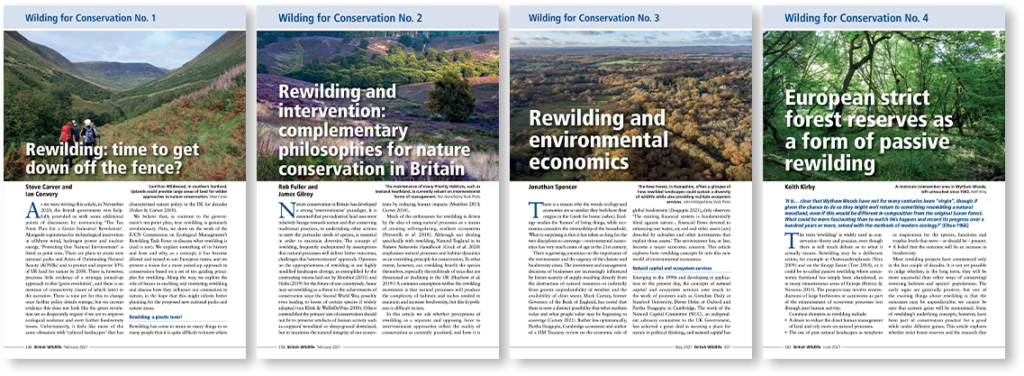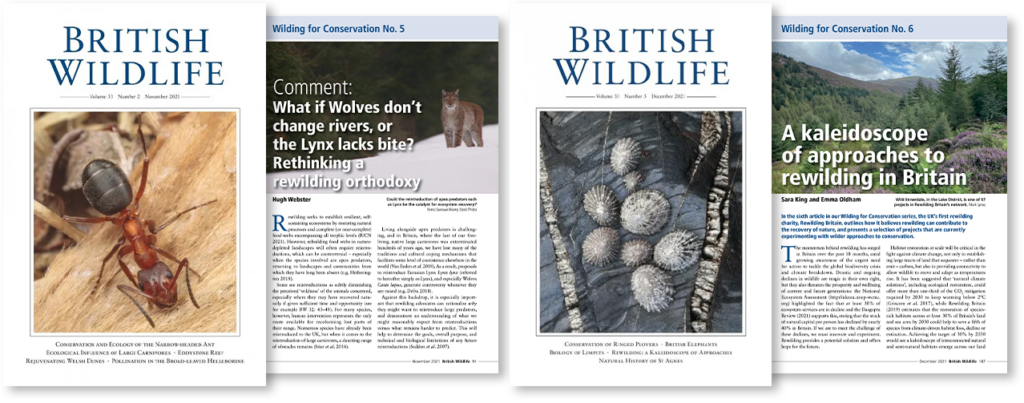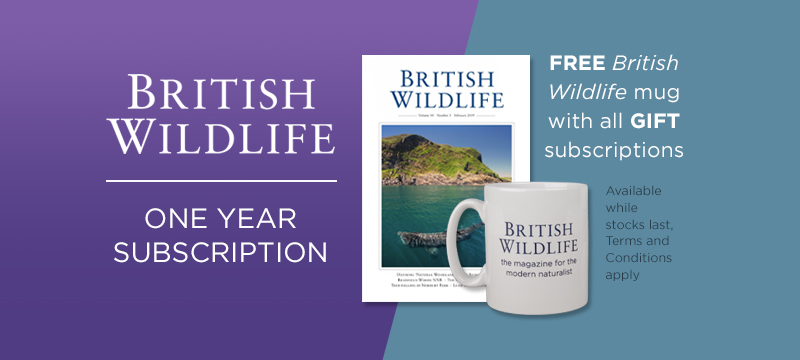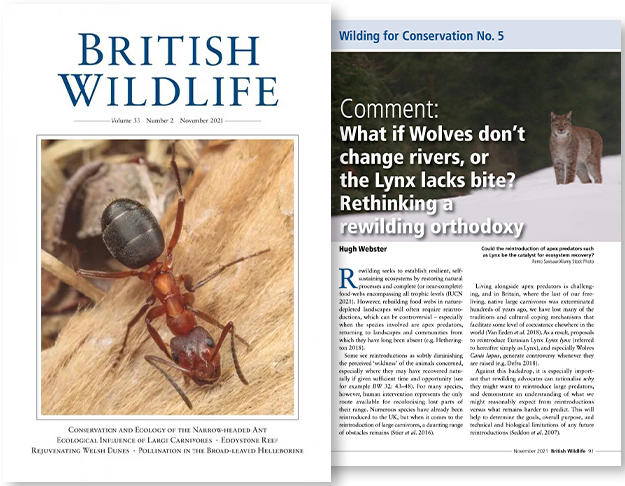Rewilding has remained very much in vogue over the past 12 months: a wealth of new initiatives and enterprises have emerged, ‘celebrity rewilders’ have made headlines and, most significantly, Defra has announced recently that one part of the new, restructured farm-subsidy system in England will incentivise a switch from agriculture to nature restoration on large landholdings. With momentum only set to build, discussion of the direction of travel, and opportunities and challenges for rewilding remains as important as ever – the ‘Wilding for Conservation’ series, launched in British Wildlife at the start of 2021, aims to provide a forum for that discussion. Here, we revisit the varied topics covered in the series’ first year and look ahead to articles coming up in 2022 and beyond.
 Wilding for Conservation, edited by Rob Fuller, began in the February 2021 issue of British Wildlife with an editorial explaining the aims of the series, including to ‘explore the many facets of rewilding as they relate to conservation in Britain’ and ‘bring ideas contained within the expanding scientific and cultural literature to a wider audience, while providing examples of what is happening on the ground in the UK and elsewhere’.
Wilding for Conservation, edited by Rob Fuller, began in the February 2021 issue of British Wildlife with an editorial explaining the aims of the series, including to ‘explore the many facets of rewilding as they relate to conservation in Britain’ and ‘bring ideas contained within the expanding scientific and cultural literature to a wider audience, while providing examples of what is happening on the ground in the UK and elsewhere’.
That same issue featured the first two articles in the series. To start, Steve Carver and Ian Convery set out the history and principles of rewilding, and argued that this approach in its pure form could offer a more ambitious future for conservation in Britain. Accompanying this was a piece by Rob Fuller and James Gilroy, who examined the limitations of, and similarities between, rewilding and ‘traditional’ conservation management, and discussed how the two could be used in tandem to produce the greatest possible benefit for wildlife.
In the May 2021 issue, Jonathan Spencer explored the economics of rewilding, offering a brief history of how industry first maintained, and then later destroyed, high-nature-value habitats, and explaining how the emergence of natural capital approaches and changes to farm subsidies could present new financial opportunities for rewilding enterprises.
In June, Keith Kirby, described European strict forest reserves – protected woodlands left to develop with minimal intervention – and outlined how these might provide lessons for rewilding in British forests.
 In the November issue, Hugh Webster reviewed the ability of large carnivores, including wolf and lynx, to regulate populations of other species, and cautioned against building the case for reintroduction of apex predators on their potential ecological benefits, which may fail to materialise.
In the November issue, Hugh Webster reviewed the ability of large carnivores, including wolf and lynx, to regulate populations of other species, and cautioned against building the case for reintroduction of apex predators on their potential ecological benefits, which may fail to materialise.
Most recently, in December 2021, the charity Rewilding Britain introduced a selection of projects currently trialling wilder approaches to conservation, and explained how rewilding can be applied, and yield benefits, in a great variety of contexts.
Wilding for Conservation will continue through 2022 and beyond with articles on a range of topics, including a landscape-history perspective on the limits of rewilding, the reality of passive rewilding in established woodland, the roles of rewilding in carbon storage and mitigating the impacts of climate change on wildlife, case studies on the New Forest and Southern Uplands of Scotland, and much more. And alongside the series, British Wildlife will continue to bring readers the best of natural history and species conservation, and the most important developments in environmental policy.
 British Wildlife is a subscription-only magazine which has been published by NHBS since 2016. Annual subscriptions, starting from just £40, can be taken out online, by email (info@britishwildlife.com) or by phone (01803 467166). Individual back issues of British Wildlife are available to buy from the NHBS website.
British Wildlife is a subscription-only magazine which has been published by NHBS since 2016. Annual subscriptions, starting from just £40, can be taken out online, by email (info@britishwildlife.com) or by phone (01803 467166). Individual back issues of British Wildlife are available to buy from the NHBS website.

